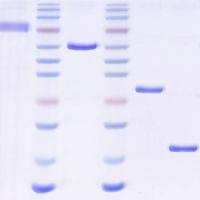Case Study on Live Cell Apoptosis-Assay Using Lamin-Chromobody Cell-Lines for High-Content Analysis
互联网
541
The understanding of cellular processes and their physiopathological alterations requires comprehensive data on the abundance, distribution, modification and interaction of cellular components. On the one hand, artificially introduced fluorescent fusion proteins provide information about their distribution and dynamics in living cells but not on endogenous factors. On the other hand, antibodies can detect endogenous proteins, posttranslational modifications and other cellular components but mostly in fixed and permeabilized cells. Here we highlight a new technology based on the antigen-binding domain of heavy-chain antibodies (VHH) from Camelidae . We have demonstrated that these VHH domains can be fused with fluorescent proteins and expressed in living cells. Those fluorescent antigen-binding proteins-called chromobodies-can be used to detect and trace proteins and other cellular components in vivo. In principle chromobodies can detect any antigenic structure including posttranslational modifications or nonprotein components and thereby dramatically expand the quality and quantity of information that can be gathered in high-content analyses. Here we demonstrate the suitability of this technology to follow apoptosis in living cells in real time.









